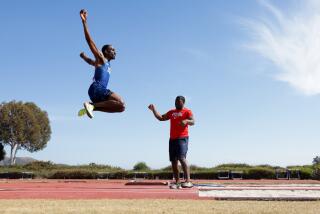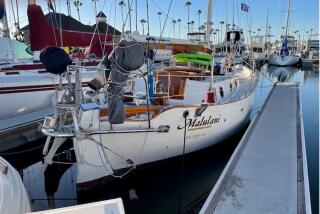Sailors Without Sight Delight in Wind, Waves
MIAMI â Night Moves skims smoothly across Biscayne Bay at sunset as Robert Rodriguez works the bow of the 22-foot sailboat, pulling on sheets to maneuver the sails as the sun dips behind the Miami skyline.
Rodriguez canât see the stunning skyline and can only make out the shape of the sails -- his sight is impaired. His onboard grace comes from memorizing the boat, his instinct for the timing of his moves and his trust in the commands being yelled by a sighted sailor at the helm.
âI assist in the sailing of the boat with a pretty wide range of senses,â he said. âI trim the boat by the feel, by the angle of the heel of the boat. I can sense when the boat slows down and speeds up. I tend to sail barefoot so I can feel the vibration of the boat. My ears can hear the wind.â
Rodriguez, 38, got his first taste of sailing four years ago when he heard about Shake-A-Leg Miami, which offers lessons to people with disabilities, as well as able-bodied wannabe sailors and disadvantaged children. The blind-sailing program has been in place since 1994.
For Rodriguez, sailing was on a list of goals he drew up after he was diagnosed with cone-rod dystrophy at age 28. It is a degenerative disorder; Rodriguez says he loses about 3% of his vision every year. He can still see shapes, but eventually heâll be completely blind. Instead of being hindered by his disability, he chose to challenge his other senses at sea and sought out sailing lessons.
Shake-A-Leg Miami was established in Coconut Grove in 1990 by Harry Horgan, executive director, who had set up a similar program in Newport, R.I.
The nonprofit organization, which operates on $1 million a year, works year-round with more than 8,000 people, about half of them physically or developmentally disabled.
A car accident 20 years ago left Allen Fiske, 56, a paraplegic. A lifelong sailor, he thought he had to give it up. But he started sailing again through the Newport program before moving to Florida, where he is outreach director at Shake-A-Leg Miami.
âWhen you become disabled, to some extent, you lose control of aspects of your life,â he said. âThis enables you to have some sort of control back in your life.â
Although estimates vary, there are about 10 million blind and visually impaired people in the United States. Of that number, about 1.3 million are legally blind, according to the American Foundation for the Blind.
There are blind-sailing programs worldwide, with competitions several times a year.
Rodriguezâ last race was the World Blind Sailing Championships in Italy in September. His team finished 10th out of 14 boats in his division.
In world competitions, blind sailors race under one of three categories of vision loss. B1 is completely blind. Rodriguez is considered a B2 racer, although heâll eventually become a B1 racer as his vision degenerates.
âWhen I started, I knew ... that progressively my vision was getting worse,â he said. âSo from the very beginning, I would sail with my eyes closed so I wouldnât get used to sailing with vision.â
But even though his moderate vision loss will eventually become worse, his teammates say his skills are top-notch.
âRobert moves like a ballerina on a boat,â said Marco Oquendo, who calls out commands and serves as Rodriguezâ eyes on the water. âHeâs very agile. When I first met him, I didnât know he was visually impaired.â
âIâm the canvas and heâs the painter,â Rodriguez said. âI realized the only way I can do it efficiently is to be void, literally void of anything. I become an extension of him and try to execute instantaneously, which is hard to do because you have to respond after the commands are given.â
Rodriguez and Oquendo, a Coast Guard reservist, are half of a four-member team training for the Blind National Championship in Newport, R.I., this week.
Theyâve been training for weeks and taking part in weekly races against other boats, manned by both disabled and able-bodied sailors.
On a recent evening, Night Moves was one of more than a dozen boats on the bay. The wind whipped the jib into a frenzy, and Rodriguez and Oquendo struggled to get the boat out of the marina. They lowered the small sail and relied on the main sail to take them into open waters. They rushed to the starting line in time for the second race that night.
âThree, two, one ... tacking,â Oquendo yelled. âComing about!â Everyone ducked to avoid being hit by the boom and jumped to the other side of the sailboat to shift the weight, while Rodriguez worked the sails.
âItâs mind, body and soul,â Rodriguez said. âYouâve got to think; youâve got to react. Youâre dealing with nature. Every day is different.â
More to Read
Sign up for The Wild
Weâll help you find the best places to hike, bike and run, as well as the perfect silent spots for meditation and yoga.
You may occasionally receive promotional content from the Los Angeles Times.






